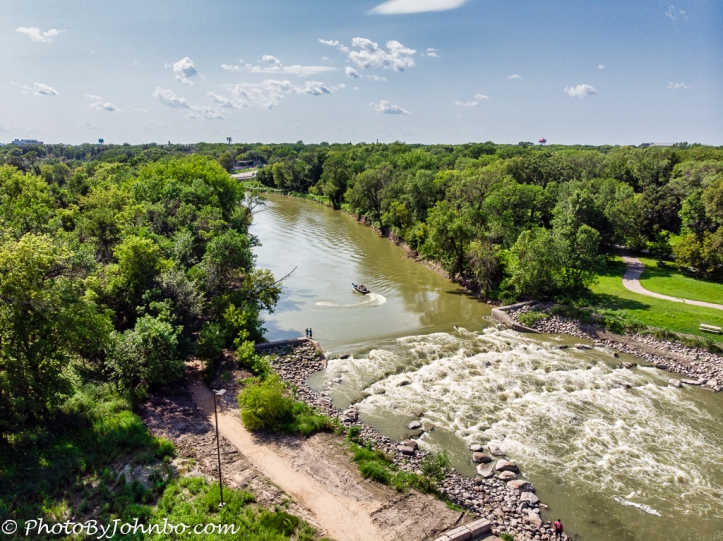The Red River forms the border between North Dakota and Minnesota and is one of the few rivers in the country to flow north, its headwaters begin at the confluence of the Ottertail and Bois de Sioux Rivers near the city of Breckenridge, Minnesota. From there it meanders northward separating the two states until it leaves the United States near the border crossing just north of Pembina, North Dakota. It finally terminates at Lake Winnipeg, the fifth largest lake in Canada.
The lowland river valley is subject to annual flooding each spring along the entire path of the river. Some years have been devastating to property along the shoreline. Most years, however, the flooding is contained to areas long since known to flood and property further east or west of the river is usually protected by either permanent or temporary dikes.
In the summer, however, the river is a source of recreation for the residents of the region. This week I present for your review a bird’s eye view of the Red River captured with the Mavic Air drone I’ve added to my camera collection. On a mid-August day, Lynn and I stopped near the bridge known locally as the 12th Avenue North bridge, though in Moorhead, the bridge joins 15th Avenue North to Fargo’s 12th Avenue North.
About the photo: Captured with the camera in the Mavic Air, the airframe hovering about 75 feet (23 m) above the parking area from where it launched. As this area is within five miles of the Fargo Hector International Airport, I was limited in altitude to less than 100 feet (30 m) and flying on an FAA-authorized flight plan, a requirement for operations near many airports around the country.
Not that the 100-foot maximum is any limitation for me. The maximum legal altitude is 400 feet (120 m) anywhere in the United States, but I’ve never flown the Air that high, nor do I plan to. As you can see by this view, it’s well above any trees and subjects like the boat and the fishermen on the bank are pretty small. I am finally used to manual exposure on the camera and a histogram is superimposed on my display screen so I can quickly adjust shutter speed. The lens is fixed at f/2.8 and i leave the ISO at 100 for minimum noise so I really only have the shutter setting to worry about. In this case, the shutter was set to 1/1250 sec. At some point, I’ll share some more of the images captured that day. To get a better view of the image, most browsers will allow you to select it and display a larger image.
John Steiner
